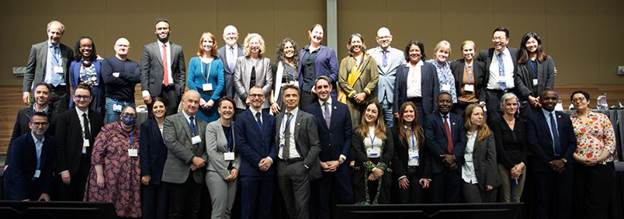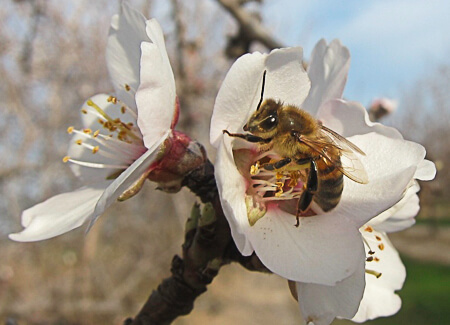July 2025: What's Polluting Preschoolers?
In this edition:
- Pollinators in Peril. Where is the Pesticide Data?
- Chemicals and Materials in the Right Place?
- Will the World Finally Address Chemical Pollution?
- Green Science Policy Institute in the News
- Calendar
I hope you are enjoying the summer. I want to acknowledge that many of us in the United States are feeling great concern about recent government actions that threaten scientific research, public health, and the future of our young scientists. In order to support current PhD and postdoctoral students whose career trajectories may be impacted by reduced research funding and federal staffing cuts, our Institute’s Senior Fellows are available to provide mentoring for young environmental scientists and engineers. Please get in touch if you or someone in your network might be interested in this opportunity.
Now, I want to call your attention to a new national study detecting dozens of harmful chemicals in two to four year old children from across the United States, providing further motivation for our work to reduce toxics. Chemicals in our Six Classes like phthalates, bisphenols, antimicrobials, and organophosphate flame retardants were all found in these young children.
In the past, brominated flame retardants were on lists like this and the fact that they are not included now could be attributed to the fact that they have not been used in furniture and children's products for over a decade. This shows that our work to reduce harmful chemicals can be effective and that we should continue our efforts! We must strive to protect our children from toxics, so they can live full and healthy lives.
Another new concern is Google’s rollout of AI Overviews and its new AI Mode. Now, instead of needing to click through to read an original article, users receive AI-generated summaries at the top of their search pages and can more quickly read these instead of going to the original articles. Washington Post’s CEO, William Lewis described the rise of click-free AI summaries in answer to searches answers as a “serious threat to journalism.”
These changes have caused search traffic to many news outlets to drop by more than half, forcing some publishers to lay off staff. We experienced this first-hand with my Forbes columns. Earlier articles like this one on disinfectant wipes had tens of thousands of views, whereas recent ones like this one on sunscreens and this one on children’s exposure to harmful chemicals from their mattresses had under 200 views. If you have any advice for navigating this problem, please get in touch.
Sharing good, unbiased science is more important than ever. For example, the world’s leading scientists who study PFAS published a statement last month expressing concerns about efforts to redefine PFAS. The new definition would likely be narrower (for example, by excluding polymers), which “may be used by some parties with vested interests to influence regulations.” Please consider joining the sign-on campaign which now has over 350 signatories.
Finally, here’s my video interview in the American Alpine Club (AAC) Legacy Series to “pay tribute to the visionary climbers who made the sport what it is today.” You might also enjoy this recent Summit Magazine interview with me and an article about our 1970 first women’s ascent of Denali, Alaska’s highest peak as recounted in my memoir Breaking Trail: A Climbing Life.
Just yesterday I learned of of the success of the 2025 Denali Damsels—eight women who reached the top of Denali last month—the highest peak in North America. They wrote me, "Thank you again for all you did to break trail for us."
Great news that we just learned today is that the European Commission is planning to end the use of PFAS in consumer products in the EU!
Kind regards,
Arlene and the Green Science Policy team
P.S. Although our work to reduce toxic harm continues unchanged, we will be moving out of our North Berkley office at the end of July. On Saturday afternoon July 19 we will be giving away office furniture and supplies. Please write me if you'd like to stop by our office to say hello and possibly take home a free desk, chair, or other office item.
Pollinators in Peril. Where is the Pesticide Data?
By Susan Kegley, Green Science Policy Institute Senior Fellow
Each year, commercial beekeepers from across the country prepare their hives for the journey to California’s Central Valley, where billions of honey bees are needed to pollinate almond orchards in February. But this year, when beekeepers opened their hives, they found many of them empty or failing. Losses ranged from 40% to as high as 90%--a catastrophic blow.
Why should we care? Honey bees pollinate about one-third of the crops we eat, including many of the most nutritious--berries, nuts, fruits, and vegetables. Their survival is directly linked to our food security and public health. But even more importantly, such large-scale bee losses are a warning sign: something is seriously wrong in the environment we share.
Multiple stressors are known to affect honey bee health, including exposure to toxic pesticides, infection by pathogens, infestations of Varroa mites, and insufficient food sources. In response to the recent crisis, the U.S. Department of Agriculture (USDA) launched an investigation, testing for viruses, mites, and pesticide exposure.
On June 5, the USDA issued a report blaming viruses and Varroa mites for the die-off. But although the agency collected pesticide residue data as part of the investigation, it was conspicuously absent from the report—and has yet to be released. This omission raises serious concerns about transparency and accountability. If pesticides played a role, the public deserves to know.
The pesticide data could reveal critical insights—not just about bee health, but about broader environmental risks. That’s why I’ve been working with the Pollinator Stewardship Council to submit a Freedom of Information Act (FOIA) request to obtain the withheld data. We are urging a swift and complete release of the pesticide results.
Meanwhile, beekeepers are doing their best to restore their colonies. And you can help. If you’re a gardener, consider planting pesticide-free, pollinator-friendly flowers to support your local bees. They need us—and we need them!
Chemicals and Materials in the Right Place?
By Lauren Heine, Green Science Policy Institute Senior Fellow
The architect and designer William McDonough famous for the Cradle to Cradle concept has argued that toxic pollution is less of a chemical toxicity problem and more of a “chemicals in the wrong place” problem. It is also an information problem. While access to information about the hazards associated with chemical options does not drive decisions to use safer chemicals, the lack of such information is a barrier.
Recently there has been a groundswell of effort to address plastic pollution. Surely plastic is a “chemical/material in the wrong place” problem: polluting waterways and oceans, harming wildlife, and leaching chemical performance additives that are toxic to humans.
It’s hard to envision any scenario where toxic additives that can leach from plastics used in products such as children’s toys, food packaging, and electronic devices are desirable; especially when safer alternatives are available.
Efforts to reduce the negative impacts of plastic waste by increasing recycling have had the unfortunate unintended consequence of recycling toxic additives such as flame retardants into products made from recycled plastics that do not need them. (Think black plastic spatula!)
Does this mean that all plastics are bad and should be banned? Might there be a “right place” (or a “least wrong place”) for plastic materials? If so, what kinds of products? Let’s do a little thought exercise about plastic products, their potential for chemical exposure, how long they are intended to last, and options for recyclability/material value recovery. Consider a plastic straw, a soda bottle, and LEGO bricks.
| Plastic Product |
Exposure Potential |
Product Longevity (decades) |
Recyclability/ Value Recovery (efficiency) |
Product Value Retention |
| Straw | Very high | Very low | Very low | Very low |
| Soda bottle | Very high | Very low | Moderate | Low-moderate |
| LEGO brick | Very high | Very high | Very low | High |
Plastics such as LEGO bricks that do not contain toxic additives and are used in products that retain their value over very long product lifetimes, and with minimal loss, are less risky. If they were recyclable, then their value retention would be even higher. An ideal world would be free of plastics in the wrong place. But perhaps focusing on the riskiest plastics will help us to get there.
Will the World Finally Address Chemical Pollution?

By Anna Soehl
The negotiations to establish an intergovernmental science-policy panel on chemical pollution concluded on June 20th in Punta del Este, Uruguay with some good and not so good news. The good news is that the multi-year long process resulted in the establishment of the Intergovernmental Science-Policy Panel on Chemicals, Waste and Pollution (ISP-CWP). And the not so good news is that many aspects of how the new Panel will operate are left undecided.
The hope however remains that this new Panel will raise awareness about the health hazards associated with chemical pollutants and encourage action to reduce harm. The establishment of the Panel puts the issue of chemical pollution on par with other planetary crises—climate change and biodiversity loss—which already have their own science-policy bodies: the Intergovernmental Panel on Climate Change (IPCC) and the Intergovernmental Science-Policy Platform on Biodiversity and Ecosystem Services (IPBES).
Our friends and colleagues attended the meetings as observers representing the voice of independent science. You can learn more via their daily briefings.
Green Science Policy Institute in the News

By Rebecca Fuoco
Below are recent news articles, blogs, podcasts, newsletters, and more that have featured our Institute’s work and expertise.
- ABC News Sacramento covered the California Safer Soap Act, for which our Institute is providing scientific support.
- UCSF Magazine recommended us as an organization to support if you care about reducing microplastic and toxic pollution.
- Arlene was interviewed by the radio station KPFA.
- Arlene was interviewed by CBC News about Canada’s ban of PFAS in clothing.
- The American Alliance of Museums’ Exhibition Journal recommends museums and exhibit designers watch our Six Classes videos.
- Country Living cited our research on the past use of flame retardants in furniture and children’s products, urging caution about thrift store couch shopping.
- A Health magazine article on reducing exposure to PFAS lists our PFAS-free webpage.
- An op-ed in The Revelator linked to our information on PFAS in firefighting foams.
- The Cool Down, picked up by Yahoo News, wrote an article about our research on flame retardants in lithium-ion batteries.
- HGA Insights recommends our Six Classes website as a starting point for designers to learn the basics of material chemistry.
Calendar
Saturday September 13, 2025, 12 - 3 PM
Comal in Berkeley, CA
Arlene and Megan Arnett, Director of the UC Berkeley Center for Green Chemistry, will present an illustrated talk on Tackling Toxics: Organohalogens and Safer Alternatives at an open meeting of the local section of the American Chemical Society including buffet lunch and networking.
More information here.
Receive Updates By Email
Subscribe to our monthly newsletter and get these updates delivered right to your inbox!



